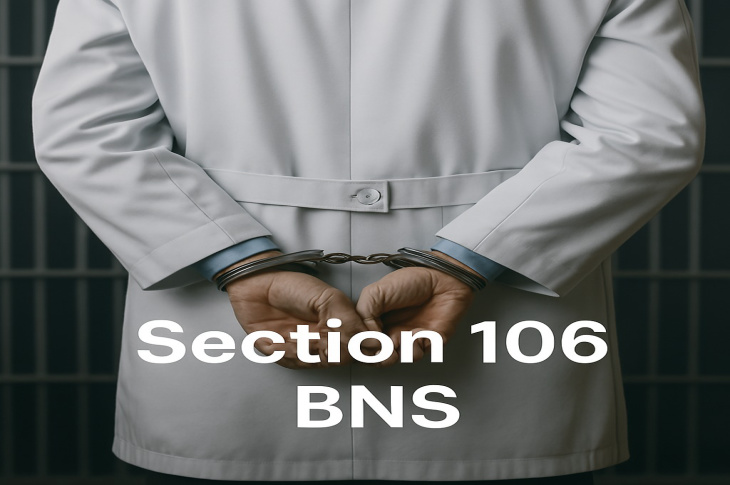Section 106 of Bharatiya Nyaya Sanhita Explained: Navigating the Laws on Death by Negligence
Introduction
With the introduction of the Bharatiya Nyaya Sanhita (BNS) in 2023, India took a bold step towards modernizing its criminal justice framework. The BNS replaces the colonial-era Indian Penal Code (IPC), bringing with it new sections and revised interpretations of criminal conduct. One such important provision is Section 106, which addresses “death by negligence.”
Section 106 plays a crucial role in balancing justice between unfortunate accidents and criminal liability. This article offers a comprehensive and easy-to-understand guide to Section 106 of BNS, exploring its text, interpretation, punishment, key legal concepts, comparisons with IPC, case laws, and real-world implications.
What is Section 106 of the Bharatiya Nyaya Sanhita (BNS)?
Section 106 BNS (Verbatim Text):
“Whoever causes the death of any person by doing any rash or negligent act not amounting to culpable homicide, shall be punished with imprisonment of either description for a term which may extend to two years, or with fine, or with both.”
Key Points:
-
Focuses on rash or negligent acts leading to death.
-
Applies only when the act does not amount to culpable homicide.
-
Punishment: Imprisonment up to 2 years, or fine, or both.
Understanding the Key Terms
1. Negligence
Negligence is the failure to exercise the care that a reasonable and prudent person would exercise in similar circumstances. It implies a lack of intention but demonstrates carelessness.
Example: A driver texting while driving and hitting a pedestrian.
2. Rash Act
A rash act is one done without due consideration or care, often in haste, but with knowledge that the act may cause harm.
Example: Over-speeding a vehicle on a crowded road.
3. Not Amounting to Culpable Homicide
Culpable homicide involves intention or knowledge that the act could likely cause death. Section 106 excludes such cases. It is applicable only when there’s no intention or knowledge of causing death.
Punishment Under Section 106
-
Imprisonment: Up to 2 years.
-
Fine: Amount is not specified, allowing judicial discretion.
-
Both: In certain cases, the court may impose both imprisonment and fine.
The punishment reflects a lesser degree of criminality, acknowledging that the death was unintentional yet caused by irresponsible conduct.
Examples of Offences Under Section 106
-
Medical Negligence: A surgeon operates without proper sterilization, causing fatal infection.
-
Construction Mishaps: A contractor ignores safety norms leading to a laborer's death.
-
Traffic Accidents: A person driving under the influence causing a fatal crash.
-
Fire Hazards: A shopkeeper stores flammable goods carelessly and a fire breaks out, killing someone.
In each case, there's no intention to kill, but carelessness leads to death, making Section 106 applicable.
Difference Between Section 106 BNS and IPC Section 304A
Section 106 of BNS replaces Section 304A of the IPC, which had similar wording:
“Whoever causes the death of any person by doing any rash or negligent act not amounting to culpable homicide…”
Comparison Table:
| Aspect | Section 304A IPC | Section 106 BNS |
|---|---|---|
| Origin | Indian Penal Code, 1860 | Bharatiya Nyaya Sanhita, 2023 |
| Language | Almost identical | Retained from IPC with minor edits |
| Punishment | Up to 2 years or fine or both | Same |
| Modern Context | Outdated in some areas | Reintroduced with a modernized criminal framework |
While there is little structural change, BNS brings better contextual clarity, improved definitions in the preamble, and consolidation of legal terms used across criminal laws.
Legal Elements to Prove Under Section 106
To secure a conviction under Section 106, the following elements must be proven in court:
-
The accused performed a negligent or rash act.
-
The act resulted in the death of another person.
-
The act did not amount to culpable homicide.
-
There was no intent or knowledge of causing death.
The burden of proof lies on the prosecution to establish these elements beyond reasonable doubt.
Judicial Interpretation and Key Case Laws
While the BNS is new, judicial interpretations from IPC’s Section 304A remain relevant. Here are key Supreme Court and High Court cases:
1. Jacob Mathew v. State of Punjab (2005)
Issue: Medical negligence resulting in death.
Ruling: Doctors cannot be held criminally liable unless it is proved that they were grossly negligent. Mere error of judgment is not enough.
Significance: Set the precedent for "gross negligence" as a criterion under 304A (and now Section 106 BNS).
2. Kurban Hussein v. State of Maharashtra (1965)
Issue: A worker died due to an industrial accident caused by negligence.
Ruling: The act must be the direct and proximate cause of death.
Significance: Reinforced the need for a clear causal link between the negligent act and the death.
3. Sushil Ansal v. State (Uphaar Cinema Fire Case)
Issue: Death of 59 persons due to fire safety negligence in a cinema hall.
Ruling: Builders and owners found guilty under Section 304A IPC.
Significance: Corporate liability and accountability for public safety lapses.
Real-Life Application of Section 106 BNS
Let’s understand how Section 106 works in practice through simplified examples:
Case 1: Road Accident by a Bus Driver
A bus driver overspeeds and hits a pedestrian crossing the road, resulting in death. He had no intent to kill, but his rash driving makes him liable under Section 106.
Case 2: Construction Site Fatality
An engineer ignores faulty scaffolding despite warnings. It collapses and kills a worker. The engineer didn’t intend harm, but the gross negligence invites liability under Section 106.
Case 3: Chemical Factory Leak
A chemical factory stores hazardous chemicals improperly. A leak occurs and a worker dies. The negligence is not intentional but still punishable under this provision.
Defenses Against Section 106 Charges
An accused under Section 106 may use the following legal defenses:
-
Absence of Negligence: Prove that the act was performed with reasonable care.
-
No Causation: Show that the act did not directly cause death.
-
Act of God: An unforeseeable event like an earthquake caused the incident.
-
Sudden Medical Condition: In road accident cases, a sudden seizure or blackout may serve as a defense.
The courts critically assess these defenses, and burden of proof may shift once initial evidence is shown.
Impact on Victims and Families
For the Victim’s Family:
-
Section 106 is not compensatory in nature.
-
Victims must file a civil suit or claim under the Motor Vehicles Act, Consumer Protection Act, or public liability laws for compensation.
-
The criminal case is for punishment, not monetary redressal.
For the Accused:
-
Punishment may be lenient, but conviction still leads to criminal record.
-
Professional licenses (e.g., doctors, engineers) may be revoked upon conviction.
-
It may also affect government jobs or foreign travel.
Why Section 106 Matters in Today’s India
As India urbanizes rapidly, accidental deaths due to negligence are on the rise — in hospitals, roads, construction sites, and public spaces.
-
Over 1.5 lakh people die every year in road accidents alone.
-
Workplace safety remains poor in unorganized sectors.
-
Medical negligence cases are increasingly being reported.
Section 106 ensures that the law responds to these tragedies firmly yet fairly, recognizing the human error but also ensuring accountability.
Need for a Criminal Lawyer Under Section 106 BNS
Whether you're accused or a victim’s family member, consulting a criminal lawyer is crucial:
For the Accused:
-
A lawyer can help prove absence of negligence or lack of causation.
-
Ensures rights are protected during arrest and investigation.
-
Can negotiate for bail or plea bargaining.
For the Victim’s Family:
-
Helps initiate criminal complaint and FIR.
-
Can guide on compensation claims through civil or consumer forums.
-
Ensures court monitoring of the case.
A skilled lawyer can make the difference between justice served and justice denied.
Policy Suggestions to Strengthen Section 106 Implementation
-
Mandatory Safety Audits: Especially in high-risk sectors like construction and manufacturing.
-
Awareness Drives: To educate professionals about their legal responsibilities.
-
Digital Evidence Collection: From CCTVs, wearable devices, or vehicles for stronger proof.
-
Special Courts: For accident and negligence cases to speed up justice delivery.
-
Better Compensation Mechanisms: Linked to criminal conviction under Section 106.
Conclusion
Section 106 of the Bharatiya Nyaya Sanhita is a critical legal provision that deals with the delicate intersection of accident and accountability. It does not treat accidents as mere misfortunes if they arise out of rash or negligent behavior. Instead, it assigns criminal responsibility, albeit without equating it to murder or culpable homicide.
As India strives toward better rule of law and safety norms, Section 106 ensures that negligence is not brushed aside, and those affected by such acts are not left without justice.
Frequently asked questions
Can a doctor be charged under Section 106?
Can a doctor be charged under Section 106?
Yes, in cases of gross medical negligence resulting in death.
Is intent required under Section 106 BNS?
Is intent required under Section 106 BNS?
No. Section 106 is based on negligence or rashness, not intent.
What is the difference between Section 106 BNS and culpable homicide?
What is the difference between Section 106 BNS and culpable homicide?
Culpable homicide involves intent or knowledge; Section 106 applies when there's no intent, only negligence.
Can compensation be claimed under Section 106 BNS?
Can compensation be claimed under Section 106 BNS?
Section 106 is a criminal law provision. For compensation, one must file a separate civil suit or approach tribunals.
Can a person get bail if charged under Section 106?
Can a person get bail if charged under Section 106?
Yes, it's a bailable offense, and courts often grant bail unless there are aggravating factors.
Trending
Frequently asked questions
Can a doctor be charged under Section 106?
Can a doctor be charged under Section 106?
Yes, in cases of gross medical negligence resulting in death.
Is intent required under Section 106 BNS?
Is intent required under Section 106 BNS?
No. Section 106 is based on negligence or rashness, not intent.
What is the difference between Section 106 BNS and culpable homicide?
What is the difference between Section 106 BNS and culpable homicide?
Culpable homicide involves intent or knowledge; Section 106 applies when there's no intent, only negligence.
Can compensation be claimed under Section 106 BNS?
Can compensation be claimed under Section 106 BNS?
Section 106 is a criminal law provision. For compensation, one must file a separate civil suit or approach tribunals.
Can a person get bail if charged under Section 106?
Can a person get bail if charged under Section 106?
Yes, it's a bailable offense, and courts often grant bail unless there are aggravating factors.



Ask a Lawyer